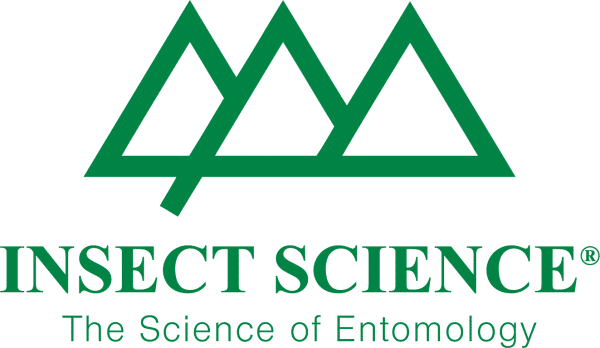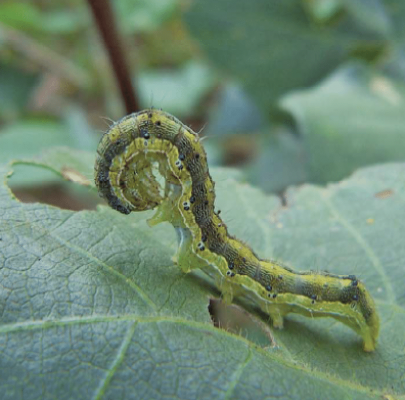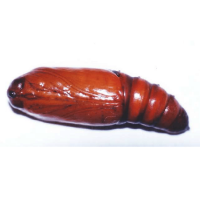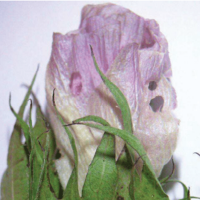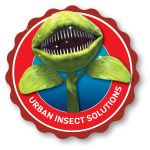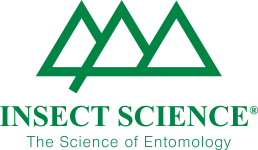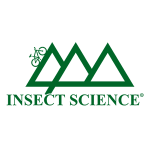Host plants
The African bollworm is undoubtedly the most polyphagous agricultural pest in southern Africa, attacking almost all field crops in addition to a wide range of deciduous fruit, vegetables and ornamental flowers. It is also found on a large variety of indigenous plants, many of which are listed by Kroon (1999). It also occurs commonly on weed species found in and around cotton fields, including several malvaceous plants, in particular Abutilon austro-africanum, Abultilon guineense, Acanthospermum hispidum, Cienfuegosia hildebrandtii, Corchorus trilocularis, Hibiscus vitifolius, Fusticia flava and Pavonia burchellii.
Damage
Young larvae feed on the small buds (illustrated), known as pin-head squares, making holes on the outer bracteoles of the squares before entering the bud to feed. Although it is mainly the squares that are damaged, the flowers and bolls are also attacked, but to a lesser extent. A high percentage of squares may drop to the ground, so-called shedding of squares, which affects yield negatively. Larger larvae often damage open flowers (illustrated) and fourth, fifth and sixth instars damage larger bolls (illustrated). Larvae also feed on the leaves and stems of cotton plants.
Life history
The African bollworm is mainly a middle season pest on cotton, and it occurs in the fruit formation phase and peak phase of cotton, from 12-14 weeks after planting. The fruit formation stage starts at six weeks after planting when the first squares start to form, and it is at this stage when the African bollworm starts to lay eggs, mainly on young squares, but also on the upper surface of cotton leaves. The female moth starts to mate and lay eggs about four days after emerging from the pupa and lays an average of about 730 eggs and at most 1600, during about 2-3 weeks or more of her lifespan. The eggs, usually laid 2-3 per leaf or square hatch after 2-4 days in late spring or summer after which the young larvae enter the squares to feed, later attacking the flowers and bolls. There are five or six larval instars and the entire larval stage last about 2-3 weeks, depending on temperature.
The fully grown larva burrows into the soil where it pupates at a depth of up to about 180 mm beneath the surface. In midsummer the pupal stage may be as short as 15 days, which may give rise to two or more moth flights during February and March. However, the pupal stage usually becomes longer with the onset of cool weather in late summer and most pupae will overwinter in a state of diapause, emerging as adults in spring during September and October. The adult moths are strong flyers and are most active from sunset until dark.
Natural enemies
Numerous indigenous parasitoids, mainly tachinid flies and parasitic wasps of various families, are known to attack Helicoverpa armigera in Africa, many of which have been documented by Van den Berg et al. (1988). Common among the wasps known from southern Africa are the egg parasitoids Trichogrammatoidea lutea Girault (Trichogrammatidae) and Telenomus ullyetti Nixon (Scelionidae), and the larval parasitoid Chelonus curvimaculants Cameron (Braconidae). Tachinid flies include the larval parasitoids Paradrino halli (Curran) and Drino laxa (Curran). During the 1970s and the 1980s several parasitoids were introduced into South Africa from various other countries for the control of African bollworm on cotton and other crops. These included the trichogrammatid egg parasitoids Trichogramma chilonis Ishii, T. perkensi Girault, T. semifumatum (Perkins), T. ostriniae Pang & Chen, T. pretiosum Riley and Trichogrammatoidea brasiliensis (Ashmead) in addition to the larval parasitoid Cotesia kazak (Telenga) (Braconidae). With the exception of T. pretiosum none of the species became established. Recorded predators include a wide range of insects such as ground and ladybird beetles, ants, earwigs, anthocorid and mirid bugs and lacewings, in addition to spiders and predatory mites.
Management
Although the complex of indigenous parasitoids and predators contribute to the suppression of bollworm populations in the field, it is unable to keep bollworm numbers under economic threshold. With the introduction of transgenic Bt-cotton varieties to South Africa, chemical control of the bollworm complex, comprising the African bollworm, red bollworm and spiny bollworm, has decreased. Only in rare instances where bollworm thresholds are reached for Bt-cotton varieties, is it still necessary to spray, in which case contact insecticides should preferably be used, followed by a systemic insecticide if necessary
Bt-cotton varieties, expressing inherent bollworm resistance, are planted to control the bollworm complex. These varieties may require chemical intervention when bollworm infestations are extreme. To combat the possible development of resistance to the Bt proteins, an area of non-Bt-cotton, called refuge, is planted. The purpose of the refuge is to harbour an adequate population of individuals not exposed to the Bt-protein and therefore not resistant to it. These non-resistant individuals will pair with potentially resistant individuals emerging from adjacent Bt fields. The refuge cotton planted should either be five or 20% or the total area; in the latter case only, is chemical intervention indicated and then only once the threshold has been reached.
The threshold for conventional (refuge) cotton is reached when five or more larvae of the bollworm complex per 24 plants are observed. For Bt varieties, the threshold is reached when one or more larvae of the complex is observed on five or more plants out of the 24 plants scouted.
Small, first instar larvae are often found inside squares, which should be opened during scouting to observe and identify the different instars of all the species in the bollworm complex. During scouting it is important to distinguish between first instar larvae that have not yet fed and larvae that have fed, as fed larvae, having ingested the Bt-endotoxin, should soon succumb. Distinct morphological differences are evident in fed and unfed larvae. Unfed larvae have a short, narrow pronotal shield and a relatively short body compared to a fed larvae, where the pronotal shield is long and wide and the body appears longer (K. Hake, pers. comm.). Unfed and moribund larvae should be disregarded when determining whether the economic threshold has been reached, as moribund larvae, although contributing to the larval count, do not warrant chemical intervention.
Guidelines for the use of pesticides for the integrated pest management of cotton pests in South Africa is provided by Basson (1987) who cautions against the use of synthetic pyrethroids, which are non-selective, often giving rise to secondary outbreaks of pests such as mites, cotton stainers and aphids. In any event, pyrethroids should never be used in the pyrethroid free window, between, 8-12 weeks after plant emergence.
